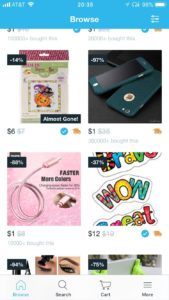Wish – The Platform for the Cost-Conscious Consumer

Wish, the online marketplace for unbranded goods, is currently the top free shopping app for both iOS and Android, helping to support its $8 billion valuation. The app allows users to shop for millions of SKUs in categories such as clothes, jewelry, and electronics, sold at bargain prices. The platform creates value for consumers, suppliers, and itself, but can it defend its position against titans such as Amazon and eBay?
Wish, the online marketplace for unbranded goods, is currently the top free shopping app for both iOS and Android, helping to support its $8 billion valuation. The app allows users to shop for millions of SKUs in categories such as clothes, jewelry, and electronics, sold at bargain prices. To offer these bargain prices, users sacrifice delivery speed and product brands, as Wish’s products – generally unbranded and sourced from the overcapacity of Chinese manufactures – may take two to four weeks to ship to the U.S. or Europe. Wish is growing participants on both sides of its platform: consumers attracted to its low prices, and merchants, eager to sell excess capacity. Wish now serves over 2 million orders per day, maintains over 300 million users and earns over $1 billion in revenue a year.
Demand Side: Wish increases awareness for its platform through an aggressive marketing campaign. In 2016, Wish spent $100 million on Facebook ads – Facebook’s 2nd highest paying customer – and paid between $12-14 million to have its logo featured on the Los Angeles Lakers jerseys. Wish also invests VC money heavily into developing its algorithms to help the user-experience functionality. To reduce information asymmetry Wish utilizes a rating system to show the reviews and star-ratings for products – often with thousands of inputs to ensure the customer of quality. Multi-homing is not necessarily a concern for Wish, as consumers may be on both Wish and Amazon, due to their different value propositions. An argument can be made that Amazon can complement Wish, by introducing a previously non e-commerce consumer to online shopping, and then allowing the two contrasting value propositions help the consumer decide which platform is more suited for their purchase or shopping experience.
Supply Side: Wish designs its site to minimize friction points for unbranded manufacturers to list their products. A manufacturer simply uploads a CSV file or manually inputs items to the site and can begin selling immediately. Wish charges a flat rate of 15% of the sale price, per transaction, which it claims covers the cost of connecting the suppliers to a diverse customers base from previously inaccessible markets: from the U.S. to the Netherlands or from Brazil to Australia.
Network effects: Wish offers two examples of network effects on its platform. First, recruiting suppliers is aided by networks effects, as merchants notice that those who list their products on Wish generally experience increased sales quickly. Previously, hesitant suppliers were convinced after listing with Wish, as a side project, began to deliver reliable and meaningful sales, month after month. Through the increase in suppliers, Wish now offers additional categories such as Gadgets, Phone Upgrades, Home Décor, Automotive, and Hobbies as a result. The more suppliers that list with Wish, the more the platform’s supplier interface improves to allow a variety of offerings, and the easier it became to convince future suppliers to join. The increase in suppliers serves as a complement to the consumer side, where more suppliers selling their products provides increased offerings for the consumers. The increase in complements from the suppliers increases the demand from the consumers.
The second example of network effect comes from the consumer algorithm. As mentioned, Wish invests heavily into its consumer algorithm and the more consumers use, browse, and both accept and reject Wish products, the more refined Wish’s algorithm become, to eventually show a browsing consumer more offerings of value. Wish, like many platforms, is fundamentally leveraging its access to consumer data to improve on its value proposition.
Future: Wish’s success has not gone unnoticed. Both Amazon and Ebay have reacted recently to this value proposition of selling low cost items to value-conscience consumers. Both platforms have launched new $10 and below market places designed to compete with Wish. Now that the giants have noticed, a test of Wish’s defensible moat for value-conscious consumers will most likely ensue.
Sources
 https://techcrunch.com/2016/03/01/the-hot-e-commerce-app-wish-has-hundreds-of-millions-of-users-plus-other-fascinating-stats/
https://techcrunch.com/2016/03/01/the-hot-e-commerce-app-wish-has-hundreds-of-millions-of-users-plus-other-fascinating-stats/- https://www.nytimes.com/2017/05/03/magazine/the-online-marketplace-thats-a-portal-to-the-future-of-capitalism.html?_r=0
- https://www.wsj.com/articles/wish-a-direct-from-china-shopping-app-lures-bargain-hunters-1431909072
- https://techcrunch.com/2018/03/02/ebay-joins-amazon-in-battle-with-wish-with-launch-of-an-under-10-storefront/
- https://www.forbes.com/sites/parmyolson/2017/09/20/wish-8-billion-funding-amazon/
- http://www.businessinsider.com/wish-ecommerce-startup-raising-new-round-liquidation-preferences-2016-10
- http://fortune.com/2016/11/04/wish-e-commerce-startup/
- https://www.youtube.com/watch?v=GuONZw9F1v8
- https://www.recode.net/2017/9/21/16346286/lakers-sponsorship-jersey-wish-shopping-app



Thanks for the great post, EAP! Two thoughts after reading:
1) I see Walmart as another competitor that will have Wish inside its crosshairs. Prior to the rise of e-commerce, Walmart targeted specifically cost conscious customers by providing low-cost, often unbranded generic items from low-cost manufacturers. With their recent acquisition of Jet.com, they may go head-to-head with Wish in this space.
2) I think it would behoove Wish to invest in a decent due diligence system for the suppliers it allows onto its platform, especially with consumables. All it would take is for the news media to identify one batch of sick kids due to a non-compliant overseas manufacturer’s product, and Wish’s brand would be seriously damaged. I realize this conflicts with the network effect incentive of getting as many suppliers onto the platform as possible, but it’s something Wish should monitor.